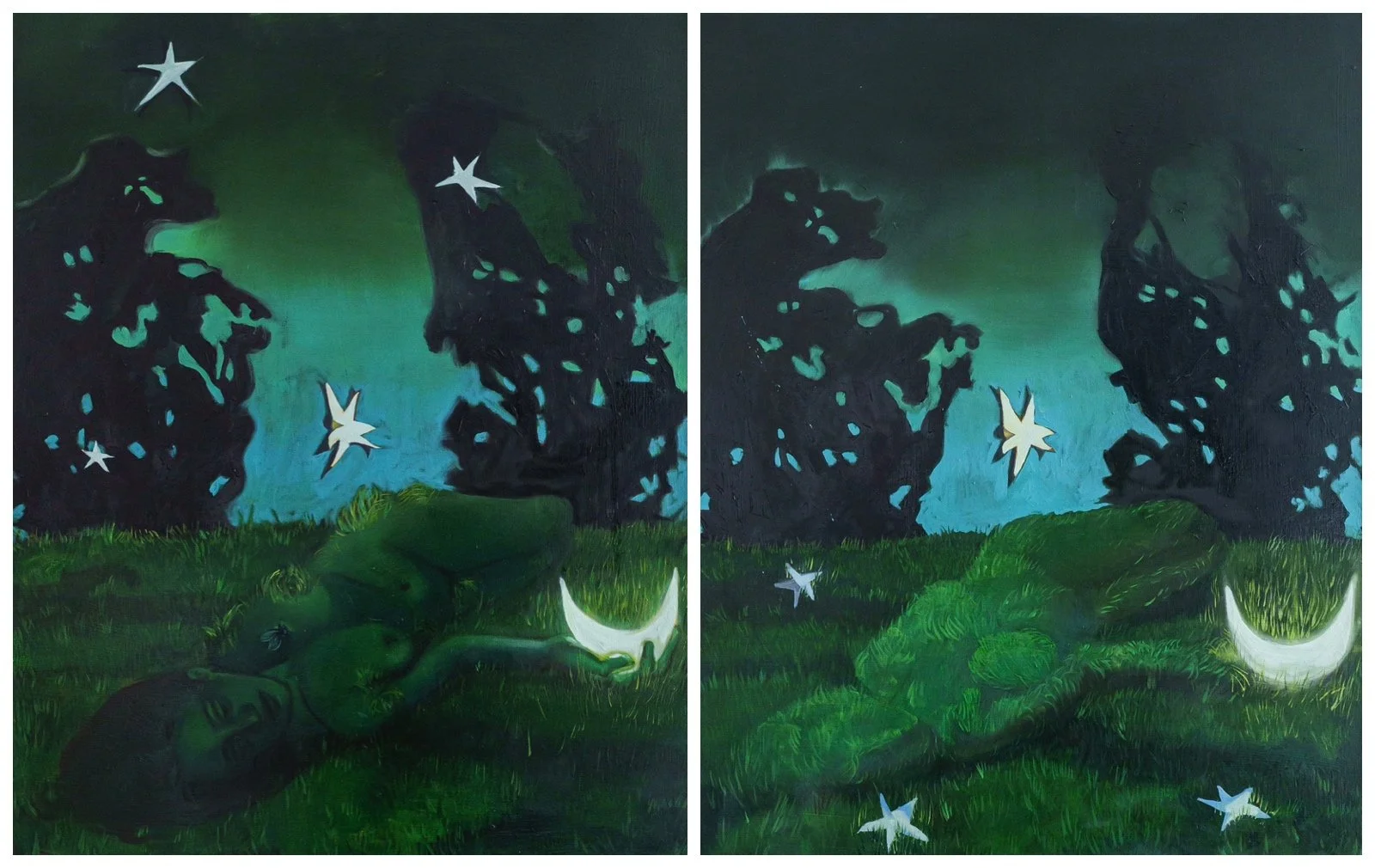When The Moon Turns Green
On view at VillageOne Gallery January 23rd to March 1st, 2025.
In past series, I have explored derealization through the creation of dreamlike worlds where figures exist within the confines of their dissociated fantasies. These imagined spaces served as both refuge and prison, where the boundaries of reality blurred into the surreal. In this new series, my figures begin the deconstruction of that fantasy. After a period of dissociation, they are finding their way back home—grounding themselves in the tactile and visceral world.
The paper moon begins to fall, and the architecture of these dreamscapes transforms, becoming rooted in the earth. Figures lay in the long grass, wade through the murky waters, and inhabit spaces rich with sensory experiences that anchor them to reality. The tickle of grass against skin, the sting of a bee, the rustle of critters and crickets in the woods, and the flickering glow of fireflies at dusk all serve as reminders of the physical body and its connection to the world.
Dusk and dawn, those transitional times when the sky shifts between light and darkness, are central to this series. These moments of in-between mirror the fleeting clarity that can emerge from the hazy, undefined fog of dissociation. I use this to reflect upon the fragility of those slippery moments when the mind briefly settles, and the world feels both intimate and distant, solid and ephemeral.
The presence of insects serves as a continued reflection on themes of how the body holds trauma. Dragonflies are frequently symbols of transformation. I regard them in my work as representing the long, gradual process of moving from a state of emotional numbness to one of clarity and growth. Flies, often associated with death, represent the lingering presence of trauma and the decay it causes within one’s psyche. They evoke the unresolved pain that continues to haunt these figures with its gentle hum and buzz. Worms are creatures that live beneath the surface, symbolizing things that are buried or hidden — memories that are lost to time; parts of the self that are suppressed. I include this constant presence of bugs to serve as a testament to the indelible imprints left by sexual assault and the dissociation that follows.
Throughout this series, a recurring motif emerges: a glowing moth, drawn to the light despite the disorientation it causes. The moth represents yearning — whether for understanding, connection, or escape. The light is distant yet desirable, something the moth is instinctively compelled to reach, even at the risk of harm. Yet, the glow the moth seeks is within itself, suggesting that the healing my figures yearn for exists within themselves, even when the pursuit of that healing feels disorienting. And further, that path towards any external source of light is futile, and leads to derealization and unsustaining comfort. The only path worth following is one that leads back to the body. This idea reaches a culmination in the final piece of the series, where a figure — now glowing herself — lays cradled by the earth, her light pulsing softly. She is not buried but grounded, finding solace in the tactile connection to the earth, where dissociation dissolves into presence and healing. The glowing moth and figure symbolize the journey of turning inward, breaking through dissociation, and finding healing within the body.
Through these pieces, I aim to evoke the senses that pull us back to ourselves and our surroundings, capturing the duality of dissociation and reconnection. By grounding my figures in these transitional landscapes and incorporating symbols like the glowing moth, I explore the journey from disconnection to presence, from fantasy to reality, and from isolation to belonging.


